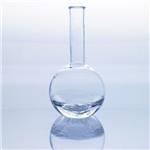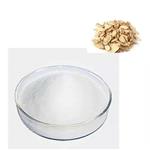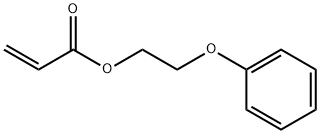Application research of 2-Phenoxyethyl acrylate
Introduction
2-Phenoxyethyl acrylate (PHEA;Figure 1) is a transparent and colorless liquid. Phenoxyethyl acrylate as the monomer, has a refractive index as high as 1.5241.The presence of the rigid phenyl group helps the internal structure of the polymer to easily change its orientation under the applied stress. [1] 2-Phenoxyethyl acrylate segments aggregated in the hydrogel network to form additional cross-linking sites during the solvent replacement process, which effectively enhanced the mechanical properties of the hydrogel. Besides, 2-phenoxyethyl acrylate can effectively penetrate the interfacial hydration layer and prevent water molecules from destroying the hydrogen bonding interaction formed between HEAA and the interface, which is an important contribution to immediate and stable underwater adhesion.[2]

MXene/PHMP hydrogels preparation
Underwater adhesion plays an essential role in soft electronics for the underwater interface. Although hydrogel-based electronics are of great interest, because of their versatility, water molecules prevent hydrogels from adhering to substrates, thus bottlenecking further applications. Herein, inspired by the barnacle proteins, MXene/PHMP hydrogels with strong repeatable underwater adhesion are developed through the random copolymerization of 2-phenoxyethyl acrylate, 2-methoxyethyl acrylate, and N-(2-hydroxyethyl) acrylamide with the presence of MXene nanosheets. The hydrogels are mechanically tough (elastic modulus of 32 kPa, fracture stress of 0.11 MPa), and 2-phenoxyethyl acrylate (PEA) with aromatic groups endows the hydrogel with nonswelling property and prevents water molecules from invading the adhesive interface, rendering the hydrogels an outstanding adhesive behavior toward various substrates (including glass, iron, polyethylene terephthalate (PET), porcine). Besides, dynamic physical interactions allow for instant and repeatable underwater adhesion. Furthermore, the MXene/PHMP hydrogels exhibit a high conductivity (0.016 S/m), fast responsiveness, and superior sensitivity as a strain sensor (gauge factor = 7.17 at 200%-500% strain) and pressure sensor (0.63 kPa-1 at 0-70kPa). The underwater applications of bionic hydrogel-based sensors have been demonstrated, such as human motion, pressure sensing, and holding objects. It is anticipated that the instant and repeatable underwater adhesive hydrogel-based sensors extend the underwater applications of hydrogel electronics.[2]
A multiple responsive photoelastic organogel preparation
The photoelastic effect has many uses in mechanics today, but it is usually disregarded in flexible materials. Using 2-phenoxyethyl acrylate as a monomer and 4-cyano-4'-pentylbiphenyl (5CB) as a solvent, a multiple responsive photoelastic organogel (PO) with strong birefringence but low modulus is created. 5CB is a liquid crystal molecule that does not participate in the polymerization process and is always present as tiny molecules in the polymer. It endows the PO low modulus and high birefringence, as well as the ability to drive the birefringence using an electric field. This PO not only has high sensitivity and fast response as a photoelastic strain sensor, but also has a very sensitive response to heat, especially in the range of human body temperature. It also has a high dielectric constant and a strong correlation between the interference color and the applied electric field, allowing for easy writing and erasure of encrypted data. This unique multisignal response feature and low modulus that mimics human skin bring up new opportunities in the potential applications such as multiple information encryption, anticounterfeiting, and multifunctional wearable sensors.[1]
A photopolymerizable resin preparation
A cataract is a cloudy area in the crystalline lens. Cataracts are the leading cause of blindness and the second cause of severe vision impairment worldwide. During cataract surgery, the clouded lens is extracted and replaced with an artificial intraocular lens, which restores the optical power. The fabrication of intraocular lenses using existing molding and lathing techniques is a complex and time-consuming process that limits the development of novel materials and designs. To overcome these limitations, Hidalgo-Alvarez et al. have developed a stereolithography-based process for producing models of clear lens designs without refractive function, serving as a proof of concept. This process has the potential to contribute toward new lens development, allowing for unlimited design iterations and an expanded range of materials for scientists to explore. Lens-like 3D objects without refractive function were fabricated by using stereolithography. A photopolymerizable resin containing 2-phenoxyethyl acrylate, poly (ethylene glycol) dimethacrylate, and a suitable photoinitiator was developed for the production of lens-like 3D object prototypes. The morphology of the printed devices was characterized by scanning electron microscopy. The transparency and thermal properties were analyzed using spectrophotometry and differential scanning calorimetry, respectively. The biocompatibility of the devices was investigated in a cultured human lens cell line (FHL-124), using a standard lactate dehydrogenase assay, and the lenses were folded and implanted in the human capsular bag model. One-piece lens-like 3D objects without refractive function and with loop-haptic design were successfully fabricated using Stereolithography (SLA) technique. The resulting 3D objects were transparent, as determined by UV spectroscopy. The lactate dehydrogenase test demonstrated the tolerance of lens cells to the prototyping material, and apparent foldability and shape recovery was observed during direct injection into a human capsular bag model in vitro. This proof-of-principle study demonstrated the potential and significance of the rapid prototyping process for research and development of lens-like 3D object prototypes, such as intraocular lenses.[3]
Flexible Materials preparation
Weigel et al. develop resins for high-resolution additive manufacturing of flexible micromaterials via projection microstereolithography (PμSL) screening formulations made from monomer 2-phenoxyethyl acrylate, the cross-linkers Ebecryl 8413, tri(propyleneglycol) diacrylate or 1,3,5-triallyl-1,3,5-triazine-2,4,6(1H,3H,5H)-trione, the photoabsorber Sudan 1, and the photoinitiator diphenyl(2,4,6-trimethylbenzoyl)phosphine oxide. PμSL-printed polymer micromaterials made from this resin library are characterized regarding achievable layer thickness depending on UV exposure energy, and for mechanical as well as optical properties. The best-candidate resin from this screening approach allows for 3D-printing transparent microchannels with a minimum cross section of approximately 35 × 46 μm2, which exhibit proper solvent resistance against water, isopropanol, ethanol, n-hexane, and HFE-7500. The mechanical properties are predestined for 3D-printing microfluidic devices with integrated functional units that require high material flexibility. Exemplarily, Weigel et al. design flexible microchannels for on-demand regulation of microdroplet sizes in microemulsion formation. These two outlines of integrated droplet regulators operate by injecting defined volumes of air, which deform the droplet-forming microchannel cross-junction, and change the droplet size therein. With this study, Weigel et al. expand the library of functional resins for PμSL printing toward flexible materials with micrometer resolution and provide the basis for further exploration of these materials, e.g., as microstructured cell-culturing substrates with defined mechanics.[4]
References
1. Gao Y, Sun D, Chen J, et al. Photoelastic Organogel with Multiple Stimuli Responses. Small. 2022;18(40):e2204140. doi:10.1002/smll.202204140
2. He S, Guo B, Sun X, et al. Bio-Inspired Instant Underwater Adhesive Hydrogel Sensors. ACS Appl Mater Interfaces. 2022;14(40):45869-45879. doi:10.1021/acsami.2c13371
3. Hidalgo-Alvarez V, Falcon ND, Eldred J, Wormstone M, Saeed A. Stereolithographic Rapid Prototyping of Clear, Foldable, Non-Refractive Intraocular Lens Designs: A Proof-of-Concept Study. Curr Eye Res. 2024;49(8):843-852. doi:10.1080/02713683.2024.2344164
4. Weigel N, M?nnel MJ, Thiele J. Flexible Materials for High-Resolution 3D Printing of Microfluidic Devices with Integrated Droplet Size Regulation. ACS Appl Mater Interfaces. 2021;13(26):31086-31101. doi:10.1021/acsami.1c05547
You may like
See also
Lastest Price from 2-Phenoxyethyl Acrylate manufacturers

US $0.00-0.00/kg2025-06-13
- CAS:
- 48145-04-6
- Min. Order:
- 1kg
- Purity:
- 99.0% min
- Supply Ability:
- 10tons

US $0.00/G/KG2025-04-22
- CAS:
- 48145-04-6
- Min. Order:
- 1G/KG
- Purity:
- 99%
- Supply Ability:
- 100MT


